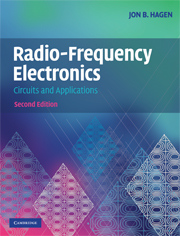Book contents
- Frontmatter
- Contents
- Preface
- 1 Introduction
- 2 Impedance matching
- 3 Linear power amplifiers
- 4 Basic filters
- 5 Frequency converters
- 6 Amplitude and frequency modulation
- 7 Radio receivers
- 8 Suppressed-carrier AM and quadrature AM (QAM)
- 9 Class-C, D, and E Power RF amplifiers
- 10 Transmission lines
- 11 Oscillators
- 12 Phase lock loops and synthesizers
- 13 Coupled-resonator bandpass filters
- 14 Transformers and baluns
- 15 Hybrid couplers
- 16 Waveguide circuits
- 17 Small-signal RF amplifiers
- 18 Demodulators and detectors
- 19 Television systems
- 20 Antennas and radio wave propagation
- 21 Radar
- 22 Digital modulation techniques
- 23 Modulation, noise, and information
- 24 Amplifier and oscillator noise analysis
- 25 The GPS Navigation system
- 26 Radio and radar astronomy
- 27 Radio spectrometry
- 28 S-parameter circuit analysis
- 29 Power supplies
- 30 RF test equipment
- Index
- References
12 - Phase lock loops and synthesizers
Published online by Cambridge University Press: 05 June 2012
- Frontmatter
- Contents
- Preface
- 1 Introduction
- 2 Impedance matching
- 3 Linear power amplifiers
- 4 Basic filters
- 5 Frequency converters
- 6 Amplitude and frequency modulation
- 7 Radio receivers
- 8 Suppressed-carrier AM and quadrature AM (QAM)
- 9 Class-C, D, and E Power RF amplifiers
- 10 Transmission lines
- 11 Oscillators
- 12 Phase lock loops and synthesizers
- 13 Coupled-resonator bandpass filters
- 14 Transformers and baluns
- 15 Hybrid couplers
- 16 Waveguide circuits
- 17 Small-signal RF amplifiers
- 18 Demodulators and detectors
- 19 Television systems
- 20 Antennas and radio wave propagation
- 21 Radar
- 22 Digital modulation techniques
- 23 Modulation, noise, and information
- 24 Amplifier and oscillator noise analysis
- 25 The GPS Navigation system
- 26 Radio and radar astronomy
- 27 Radio spectrometry
- 28 S-parameter circuit analysis
- 29 Power supplies
- 30 RF test equipment
- Index
- References
Summary
Oscillators whose frequencies are derived from a stable reference source are used in transmitters and receivers as L.O.'s for accurate digital tuning. A VCO in a loop that tracks the frequency excursions of an incoming FM signal is a commonly used FM detector. The first widespread use of phase lock loops was in television receivers where they provide noise-resistant locking of the horizontal sweep frequency to the synchronization pulses in the signal.
Phase locking
A phase lock loop (PLL) circuit forces the phase of a voltage-controlled oscillator (VCO) to follow the phase of a reference signal. Once lock is achieved, i.e., once the phases stay close to each other, the frequency of the VCO will be equal to the frequency of the reference. In one class of applications, the PLL is used to generate a stable signal whose frequency is determined by an unstable (noisy) reference signal. Here the PLL is, in effect, a narrow bandpass filter that passes a carrier, while rejecting its noise sidebands. Examples include telemetry receivers that lock onto weak pilot signals from spacecraft and various “clock smoother” circuits. It is often necessary to lock an oscillator to the suppressed carrier of a modulated signal, an operation known as carrier recovery. In yet another class of applications the PLL is designed to detect all the phase fluctuations of the reference. An example is the PLL-based FM demodulator where the VCO reproduces the input signal, which is usually in the IF band.
- Type
- Chapter
- Information
- Radio-Frequency ElectronicsCircuits and Applications, pp. 134 - 151Publisher: Cambridge University PressPrint publication year: 2009



